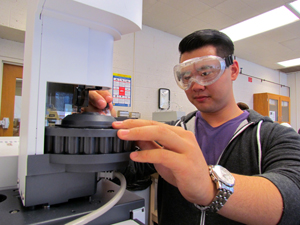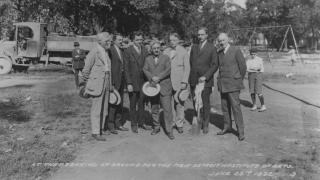

Reach into your purse or your back pocket and pull out your wallet.
Do you have a five spot or any singles?
If so, then your wallet also could hide an illegal drug.
University of Michigan-Dearborn students Justin Kandah and Aaron Zhang analyzed paper currency across Detroit and found traces of cocaine on more than half the bills.
Kandah recently collected $1 and $5 bills from gas stations, grocery stores and banks across Detroit’s seven municipal districts.
When drug dealers orchestrate a transaction, cash often comes into contact with cocaine. And many cocaine users roll bills to inhale the drug. In both instances, drug residue easily transfers onto the paper currency.
“By proxy, cocaine can transfer to all kinds of different things,” said Kandah, a bioengineering major who previously worked as a patrol officer.
Zhang placed bills in deionized water, then through sonication, was able to remove traces of cocaine from the paper currency. The cocaine in the aqueous samples was then extracted using hexane and analyzed by a gas chromatography-mass spectrometry instrument, state-of-the-art technology that allows for the identification and quantitation of cocaine.
The students analyzed 42 bills, 67 percent of which tested positive for cocaine.
“Surprisingly, 67 percent didn’t come as a shock to me because the thing about cocaine is that it transfers super easily,” said Zhang, a biological sciences major.
They analyzed bills from all seven districts and found the highest amount of cocaine on paper currency exists on Detroit’s north side. The students’ research may help provide law enforcement circles with objective and timely information on epidemiology of illicit drug use.
“This project not only gives the students an opportunity to conduct interdisciplinary research in chemistry and forensic science, but raises public awareness of drug abuse in our society,” said Yiwei Deng, associate professor of chemistry who assisted the students with their research.
Deng acknowledges the results obtained may not fully represent the epidemiology of cocaine use in this region due to the small sample size. Cocaine detected on these banknotes may not all come from local sources, as bills stay in circulation for months, during which time they get handled by different people. The majority of banknotes being contaminated indicates, however, that cocaine use is still widespread not only in southeast Michigan, but in many other areas of the U.S. Deng hopes to generate enough interest from students, so they can broaden their scope on future projects related to cocaine and paper currency.
Kandah and Zhang presented their research at the Sargon Partners’ Undergraduate Research Showcase presented by the College of Arts, Sciences, and Letters.




